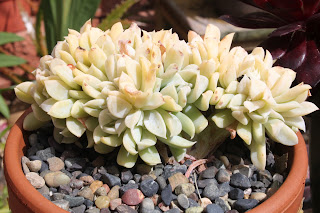September is when summer REALLY arrives in San Diego County. Weather patterns change; winds shift from the east and air masses traveling over the inland deserts, arrive at the coast. These are referred to as "Santa Ana" winds. Temps are soaring today! This is the thermometer on my shady porch. Okay, I know all my desert friends will have no sympathy for me, but it's OUR time to pay the piper!!
This is also the time when some succulents, including cactus, can get severely burned. Temps can rise very quickly. A couple of years ago, I recorded a rise of 25 degrees F within an hour! It peaked at 115F. The sun is also lower in the sky now, so it peeks under eaves that normally provide shade to sun sensitive plants. Anyone who has lost a favorite plant to severe burn, (guilty), will start moving potted plants and covering ground dwellers when the weather reports call for another Santa Ana!
 |
A couple of hours later
|
A few casualties in my garden....
This one is delosperma spalmanthoides. It was in mostly shade, but a short dose of sun caused this burn. I have no doubt it will recouperate.
Aeonium 'voodoo'. This is growing in dappled shade in the morning, full shade the remainder of the day. Sun was hot enough to burn the tender center leaves within an hour.
This aeonium grows in half day sun and closes up a little more in summer. As a result, the exposure was reduced and the burn was limited to the outer leaves.
Dracaena marginata. One branch grew too far out from underneath the eaves of our house and suffered pretty severe burn. The growing point is protected, so it should recover well.
Argyroderma testiculare. Normally, this plant likes a short dose of morning sun, but not at 100+ degrees! Gave it a drink and moved it to full shade for a while.
Sedum hispanicum. Doesn't like heat; doesn't like full sun. Should recover once Autumn is in full swing. Notice the larger sedums did fine?























































